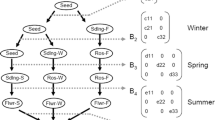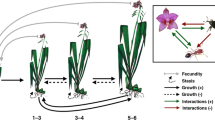Abstract
Matrix habitats are known to influence the movement patterns of a variety of species but it is less well known whether these effects have strong implications for spatial population dynamics, including the spread of biological introductions. Using a spatially explicit simulation model parameterized with empirical data, we examine how grass and shrub matrix habitats, each offering different resistance to dispersal, influence the spread and impact of a biocontrol agent, Aphthona lacertosa, on the invasive weed, leafy spurge. Model predictions indicate that differential responses to matrix habitat have little effect on the agent’s spread over the study landscape and this is supported by statistical models fit to observed A. lacertosa incidence on the same landscape. Subsequent experimentation with the simulation model suggested that A. lacertosa colonization rates were largely unaffected by increases in amount of the more restrictive shrub matrix. However, simulations of an hypothetical species with greater overall dispersal ability but reduced dispersal rate through shrub matrix showed that colonization rates were noticeably reduced when the percentage of shrub matrix on the landscape approached 50%. Combined these results suggest that some tailoring of release strategies may be required to accommodate the unique dispersal capabilities of different biocontrol agents on particular release landscapes, but for A. lacertosa there appears to be little effect of matrix habitat structure on rates of spread.





Similar content being viewed by others
References
Cain ML (1991) When do treatment differences in movement behaviors produce observable differences in long-term displacements? Ecology 72:2137–2142
Cronin JT, Reeve JD (2005) Host-parasitoid spatial ecology: a plea for a landscape-level synthesis. Proc Royal Soc London B 272(1578):2225–2235
Dennis B, Taper ML (1994) Density dependence in time series observations of natural populations: estimation and testing. Ecol Monogr 64:205–224
Fagan WF, Lewis MA, Neubert MG, van den Driessche P (2002) Invasion theory and biological control. Ecol Lett 5:148–157
Fahrig L (1997) Relative effects of habitat loss and fragmentation on population extinction. J Wildl Manage 61:603–610
Fahrig L (2001) How much habitat is enough? Biol Conserv 100:65–74
Gassmann A (1990) Aphthona lacertosa (Rosch) (Coleoptera: Chrysomelidae): a candidate for the biological control of leafy spurge and cypress spurge in North America. CAB International Institute of Biological Control, Delmont Switzerland
Goodwin BJ, Fahrig L (2002) Effect of landscape structure on the movement behaviour of a specialized goldenrod beetle, trirhabda borealis. Can J Zool 80:24–35
Grevstad FS, Herzig AL (1998) Quantifying the effects of distance and conspecifics on colonization: experiments and models using the loosestrife leaf beetle, Galerucella calmariensis. Oecologia 110:60–68
Grez AA, Zaviezo T, Rios M (2005) Ladybird (Coleoptera : Coccinellidae) dispersal in experimental fragmented alfalfa landscapes. Eur J Entomol 102:209–216
Gustafson EJ, Gardner RH (1996) The effect of landscape heterogeneity on the probability of patch colonization. Ecology 77:94–107
Hanski I, Alho J, Moilanen A (2000). Estimating the parameters of survival and migration of individuals in metapopulations. Ecology 81:239–251
Hastie TJ, Tibshirani R (1990) Generalized Additive Models. Chapman and Hall, London
Haynes KJ, Cronin JT (2003) Matrix composition affects the spatial ecology of prairie planthopper. Ecology 84:2856–2866
Haynes KJ, Cronin JT (2004) Confounding of patch quality and matrix effects in herbivore movement studies. Landsc Ecol 19:119–124
Huffaker CB, Kennett CE (1959) A ten-year study of vegetational changes associated with biological control of Klamath Weed. J Range Manage 12:69–82
Jonsen ID (2002) The spatial dynamics of Aphthona flea beetles on the invasive weed, leafy spurge. Ph D. Thesis, University of Alberta, Edmonton
Jonsen ID, Bourchier RS, Roland J (2001). The influence of matrix habitat on aphthona flea beetle immigration to leafy spurge patches. Oecologia 127:287–294
Jonsen ID, Taylor PD (2000a) Calopteryx damselfly dispersions arising from multiscale responses to landscape structure. Conserv Ecol, 4, 4 [Online] URL: http://www.consecol.org/vol4/iss2/art4.
Jonsen ID, Taylor PD (2000b) Fine-scale movement behaviors of calopterygid damselflies are influenced by landscape structure: an experimental manipulation. Oikos 88:553–562
Kareiva P (1985) Finding and losing host plants by Phyllotreta: patc size and surrounding habitat. Ecology 66:1809–1816
Kean JM, Barlow ND (2000) The effects of density-dependence and local dispersal in individual-based stochastic metapopulations. Oikos 88:283–290
Larson DL, Grace JB (2004) Temporal dynamics of leafy spurge (Euphorbia esula) and two species of flea beetles (Aphthona spp.) used as biological control agents. Biol Control 29:207–214
Lonsdale WM, Farrell G, Wilson CG (1995) Biological control of a tropical weed: a population model and experiment for Sida acuta. J Appl Ecol 32:391–399
Matter SF, Roland J, Moilanen A, Hanski I (2004) Migration and survival of parnassius smintheus: detecting effects of habitat for individual butterflies. Ecol Appl 14:1526–1534
McEvoy PB, Coombs EM (2000) Why things bite back: unintended consequences of biological weed control. In: Follet PA, Duan JJ (eds) Nontarget effectgs of biological control. Kluwer Academic Publishers, London, pp 167–194
McEvoy PB, Rudd NT, Cox CS, Huso M (1993) Disturbance, competition, and herbivory effects on ragwort Scenecio jacobaea populations. Ecol Monogr 63:55–75
Moilanen A, Hanski I (1998) Metapopulation dynamics: effects of habitat quality and landscape structure. Ecology 79:2503–2515
Morales JM, Ellner SP (2002) Scaling up movement in heterogeneous landscapes: the importance of behavior. Ecology 83:2240–2247
Petit S, Moilanen A, Hanski I, Baguette M (2001) Metapopulation dynamics of the bog fritillary butterfly: movements between habitat patches. Oikos 92:491–500
Pinheiro JC, Bates DM (2000) Mixed-effects models in S and S-PLUS. Springer-Verlag, New York
Pither J, Taylor PD (1998) An experimental assessment of landscape connectivity. Oikos 83:166–174
Ricketts TH (2001) The matrix matters: effective isolation in fragmented habitats. Am Nat 158:87–99
Roland J, Keyghobadi N, Fownes S (2000) Alpine Parnassius butterfly dispersal: effects of landscape and population size. Ecology 81:1643–1653
Ross JA, Matter SF, Roland J (2005) Edge avoidance and movement of the butterfly parnassius smintheus in matrix and non-matrix habitat. Landsc Ecol 20:127–135
Rudd NT, McEvoy PB (1996) Local dispersal by the cinnabar moth Tyria jacobaeae. Ecol Appl 6:285–297
Shea K, Kelly D (1998) Estimating biocontrol agent impact with matrix models: Carduus nutans in New zealand. Ecol Appl 8:824–832
Sheppard AW, Smith MJ, Swirepik A (2001) The impact of a root-crown weevil and pasture competition on the winter annual Echium plantagineum. J Appl Ecol 38:291–300
Shigesada N, Kawasaki K (1997) Biological invasions: theory and practice. Oxford University Press, New York
Simberloff D, Stiling P (1996). How risky is biological control? Ecology 77:1965–1974
Taylor PD, Fahrig L, Henein K, Merriam G (1993) Connectivity is a vital element of landscape structure. Oikos 68:571–573
Venables WN, Ripley BD (2002) Modern applied statistics with S, 4th edn. Springer-Verlag, London
Wahlberg N, Klemetti T, Selonen V, Hanski I (2002) Metapopulation structure and movements in five species of checkerspot butterflies. Oecologia 130:33–43
With KA (2002). The landscape ecology of invasive spread. Conserv Biol 16:1192–1203
With KA, King AW (1999) Estinction thresholds for species in fractal landscapes. Conserv Biol 13:314–326
With KA, Pavuk DA, Worchuk JL, Oates RK, Fisher JL (2002) Threshold effects of landscape structure on biological control in agroecosystems. Ecol Appl 12:53–65
Acknowledgements
We thank Jeff Rau, Jeremy Fox, Tia Fox, Linda van Heek, Nicole Humble, Monte Thomson, and Ray Wilson for field assistance and Peter McEvoy, Mark Lewis, Mark Dale, Andrew Keddie, Anne Naeth, Kurtis Trzcinski and anonymous reviewers for helpful comments. The Blood Tribe Lands Department is thanked for access to the study area. IDJ gratefully acknowledges funding from NSERC and the University of Alberta. Additional funding was provided by AAFC (MII #A00764 to RSB).
Author information
Authors and Affiliations
Corresponding author
Rights and permissions
About this article
Cite this article
Jonsen, I.D., Bourchier, R.S. & Roland, J. Effect of matrix habitat on the spread of flea beetle introductions for biological control of leafy spurge. Landscape Ecol 22, 883–896 (2007). https://doi.org/10.1007/s10980-006-9069-z
Received:
Accepted:
Published:
Issue Date:
DOI: https://doi.org/10.1007/s10980-006-9069-z




